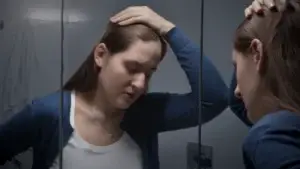

Dr. Rostislav Ignatov, MD
Chief Medical Officer
Bipolar II disorder is a mental health disorder characterized by periods of depressive episodes alternating with hypomanic episodes, which are a milder form of the full-blown manic episodes seen in bipolar I disorder.
This condition can profoundly impact a person’s daily functioning, relationships, and overall quality of life. Fortunately, there are various treatments available to help manage this condition effectively. Read on to learn more about this complex mental disorder.
Bipolar II disorder, a complex mental health condition, impacts many people in the United States. Here is what this article covers:
Bipolar II disorder is a mood disorder characterized by cyclic shifts between depressive and hypomanic episodes. While similar to bipolar I disorder, individuals with bipolar II experience hypomanic episodes rather than full-blown manic episodes. These episodes can significantly impact daily functioning and overall quality of life. Here’s an overview of the symptoms associated with hypomanic and depressive episodes in bipolar II disorder:
During hypomanic episodes, individuals often experience a noticeable increase in energy and activity levels. They may feel unusually upbeat, active, and restless, accompanied by a decreased need for sleep—functioning well on only a few hours each night. Increased talkativeness is also common, with rapid speech and a tendency to jump between topics.
Many exhibit exaggerated self-confidence or grandiosity, leading to overestimations of their abilities or importance. Thoughts may race, making it difficult to focus or concentrate, while impulsive behaviors such as reckless spending or risk-taking can occur. Additionally, individuals often engage in multiple projects or tasks at once, displaying heightened goal-directed activity and enthusiasm.
In bipolar II disorder, depressive symptoms often manifest through persistent sadness, emptiness, or hopelessness that lasts for most of the day, nearly every day. Individuals may lose interest or pleasure in activities they once enjoyed, finding that hobbies, socializing, and other past sources of joy no longer hold appeal. Depression can also lead to significant changes in appetite and weight, resulting in weight loss, weight gain, or altered eating patterns.
Sleep disturbances—such as insomnia, difficulty staying asleep, or excessive sleeping—are common, along with constant fatigue or low energy levels that make even simple daily tasks feel exhausting. Many individuals experience intense feelings of worthlessness, guilt, or self-blame, accompanied by difficulty concentrating, indecisiveness, or memory problems. In severe cases, thoughts of death or suicidal ideation may occur.
Remember, these symptoms of hypomania and depressive episodes can vary in intensity and duration from person to person. Proper diagnosis by mental health professionals is essential for ensuring effective care and treatment.
Bipolar disorder, a manic-depressive illness, is marked by extreme mood swings and manifests in various forms, with bipolar I and bipolar II being the most common types. While they share similarities, there are distinct differences between the two.
In bipolar I disorder, individuals experience full-blown episodes of mania, often accompanied by depressive episodes. On the other hand, bipolar II disorder is characterized by hypomanic episodes, which are less severe than full mania, along with depressive episodes.
Manic episodes in bipolar I disorder are typically more severe, often leading to hospital care due to their intensity and potential for reckless or erratic behavior. In bipolar II disorder, hypomanic episodes are less extreme and may even be perceived as periods of increased productivity or elevated mood.
Manic episodes in bipolar I disorder last at least seven days, while depressive episodes can persist for two weeks or more. In bipolar II disorder, hypomanic episodes last at least four days, and depressive episodes typically last for longer durations.
The impairment in functioning during manic episodes is more pronounced in bipolar I disorder, often resulting in significant disruptions to work, relationships, and daily life. In bipolar II disorder, the impairment during hypomanic episodes is less severe, but depressive episodes can still cause major difficulties in functioning. Remember, either type of bipolar disorder can have a significant impact on daily functioning, interpersonal relationships, and overall quality of life. Therefore, professional help is essential for an accurate diagnosis and proper treatment.
While the exact cause of bipolar disorder is not fully understood, several factors are believed to contribute to its onset. Here are some of the possible causes and risk factors associated with bipolar II disorder:
Genetic predisposition plays a significant part in the development of bipolar II disorder. Individuals with a family history of bipolar disorder are at a higher risk of developing the condition themselves.
Imbalances in neurotransmitters, such as serotonin, dopamine, and norepinephrine, are implicated in bipolar II disorder. Brain structure and function changes, including prefrontal cortex and limbic system abnormalities, may also contribute to its development.
Psychological factors, including stress, trauma, and unresolved emotional issues, can exacerbate symptoms of bipolar II disorder. Additionally, personality traits such as impulsivity and perfectionism may increase susceptibility to the condition.
Environmental factors, such as significant life changes, traumatic events, or chronic stressors, can trigger mood episodes in individuals with bipolar II disorder. These triggers can lead to disruptions in the delicate balance of brain chemistry, leading to episodes of depression or hypomania.
Certain medical conditions, such as thyroid disorders or neurological conditions, may elevate the risk of developing bipolar II disorder or exacerbate existing symptoms.
Substance abuse, including alcohol, illegal drugs, recreational drugs, and prescription medicines, can worsen symptoms of bipolar II disorder and interfere with treatment effectiveness. Substance abuse can also trigger mood episodes and increase the severity of the condition. Remember, bipolar II disorder is a complex condition with multiple contributing factors, and individual experiences may vary.
Living with bipolar II disorder can be challenging due to severe mood swings between depression and hypomania.
The diagnosis process for bipolar II disorder typically involves various steps to ensure accurate assessment and appropriate treatment. Here’s a breakdown of each step:
The diagnosis process typically begins with an initial assessment conducted by a healthcare provider. This assessment involves gathering information about the individual’s symptoms, medical history, and family history of mental health conditions.
Healthcare providers use established diagnostic criteria, such as those outlined in the Diagnostic and Statistical Manual of Mental Disorders (DSM-5), to determine if the individual meets the criteria for bipolar II disorder.
A physical checkup and laboratory tests, such as blood tests, may be conducted to rule out any underlying medical conditions or substance use contributing to the individual’s symptoms.
Mood tracking, such as keeping a mood journal or using digital tools, can help individuals and healthcare providers monitor mood fluctuations over time, providing valuable information for diagnosis and treatment planning.
A mental health professional may conduct a psychological evaluation to assess the individual’s overall mental health, including their thoughts, emotions, and behaviors.
Collateral information from family members or close friends may be gathered to provide additional insights into the individual’s symptoms and functioning.
Healthcare providers consider other possible diagnoses that may present with similar symptoms, such as major depressive disorder (MDD), anxiety disorders, cyclothymic disorder, or substance use disorders (SUDs).
Based on the diagnosis, healthcare providers collaborate with the individual to develop a personalized treatment plan that may include medication, therapy, lifestyle changes, and support services.
Regular follow-up appointments and monitoring are vital to track the individual’s response to treatment, adjust the treatment plan as needed, and ensure ongoing support and care. By following this comprehensive diagnosis process, healthcare providers can effectively identify bipolar II disorder and provide appropriate care and support.
Bipolar II disorder requires a comprehensive treatment approach for effective management. Here are the key treatment options:
Medication is a cornerstone of treatment for bipolar II disorder. Mood stabilizers, such as lithium or anticonvulsants, are the most common types of medications prescribed by doctors to help regulate mood changes and prevent manic or depressive episodes. Additionally, antidepressants or antipsychotic medications may be used to target specific symptoms.
Psychotherapy, or talk therapy, can be a valuable tool for bipolar patients. Cognitive behavioral therapy (CBT), interpersonal therapy (IPT), and psychoeducation can help individuals learn coping skills, identify triggers, and develop strategies for managing mood symptoms.
Self-care plays a crucial role in managing symptoms of bipolar disorder. Maintaining a regular sleep schedule, exercising daily, and avoiding alcohol and drugs can help stabilize mood. Stress management techniques such as mindfulness meditation or relaxation exercises are also beneficial.
Joining a mental health support group can provide valuable emotional support, encouragement, and practical advice. Connecting with others who understand what it’s like to live with the condition can help individuals feel less alone and more empowered to manage their bipolar symptoms effectively. By combining these treatment options, individuals with bipolar II disorder can effectively manage their severe symptoms and lead fulfilling lives.
Get answers about your cost / coverage now.
Your information will be kept private
Let’s talk about what’s going on — no judgment. (We’ve been there before ourselves). No one will know you inquired and there is no commitment to call.
24/7 Support
No Commitment
100% Private
There’s no catch. Checking your insurance is simply a way to see what your plan covers — it doesn’t lock you into treatment, notify anyone, or cost you anything. You get answers upfront to decide what makes sense for you.
Protecting your privacy matters! No information or notifications are ever sent to your employer or family — whether you check your insurance online or call. Everything is handled through secure, encrypted systems that meet strict medical privacy laws. You stay in control of your information!
Luckily, most insurance policies cover treatment here. Depending on the healthcare you’ve already had this year, costs could even be zero. Instead of worrying, let’s just find out what your plan covers.
Most likely. We work with major providers like Cigna, Aetna, and United Healthcare, public insurances like Tricare and tribal plans, and even smaller plans like Surest Bind and Harvard Pilgrim. The quickest way to know for sure is to check online or call. It’s a quick, private way to understand what is covered upfront.
Verifying your insurance isn’t a commitment to start treatment — it’s simply a way to see what your options are. Knowing your coverage ahead of time helps you make more informed, confident decisions. It also helps flag a spot, so you’re able to get right in if you ever do decide you’re ready.
You need your policy number to check your specific policy online. If you want general information, just call. You likely have questions beyond insurance anyway. Reaching out now helps you figure out the right fit if or when you’re ready. You don’t have to put off the call until you’re in crisis. Calling is not scary, I promise!